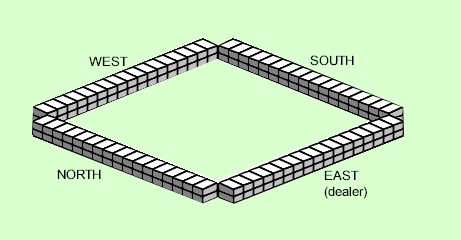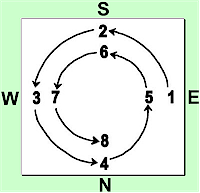 Chinese Official Mahjong -- Hands
Chinese Official Mahjong -- Hands
Mahjong is a Chinese game of skill and strategy involving 4 players. Chinese Official Mahjong is similar to other mahjong versions. The game pieces and scoring, however, slightly differ depending on regional variations of mahjong. The Online Mahjong is quite similar to gin rummy as the goal in both games is to build sets and to get the highest point value. Each player selects and discards the mahjong tiles (game pieces with different designs) until a full set of combinations has been made. Below are the Mahjong Competition Rules (Chinese Official) or the Official International Rules of mahjong -- accepted as the 25th sport by the State Sports Commission of China in January 1998.
Mahjong Tile Set
Like a set of playing cards, a mahjong tile set has suits, but instead of Hearts, Diamonds, Spades and Clubs, there are just 3 suits: Bamboos, Circles and Characters.
|
Bamboos (4 of each, 1-9) |
 
|
|
Circles (4 of each, 1-9) |
 
|
|
Characters (4 of each, 1-9) |
 
|
| There are also Honor tiles -- 3 Dragons & 4 Winds - 4 of each |


|
| Optional 8 Flowers & Seasons tiles - 4 each |  |
Tiles 1 and 9 are called as Terminals. Tiles numbered from 2 to 8 are called "Simples" and Wind and Dragon Tiles are Honors.
Mahjong Flowers
The optional Flower and Season tiles differ from the Suit and Honor tiles. There are only 4 Flowers and 4 Season tiles. When Flowers or Seasons are drawn, they are declared and a substitute tile is drawn. The Flower(s) or Season(s) that correspond to the winning player's Wind may increase the winning score.
The Flowers are represented by a plum, orchid, chrysanthemum and bamboo, and Seasons by a fisher, woodcutter, farmer and scholar. The Flowers are represented by a plum (1), an orchid (2), a chrysanthemum (3) and a bamboo (4), and Seasons by a fisherman, a woodcutter, a farmer and a scholar.
| Flower | Season/Occupation | Number | Associated Wind |
|---|---|---|---|
| Plum | Spring/Fisherman | 1 | East |
| Lily/Orchid | Summer/Woodcutter | 2 | South |
| Chrysanthemum | Autumn/Farmer | 3 | West |
| Bamboo | Winter/Scholar | 4 | North |
The Goal of Mahjong
The goal of the game is to assemble a full set ("hand"), with 4 sets of 3 and a pair. Either 3 of a kind of the same suit ("pung") or a sequence of the same suit ("chow") and a pair, for a total of 14 tiles. Each player starts with 13 tiles. With each turn, a player picks up a 14th tile and then discards 1 tile placing it face up in the center of the table. Upon discard, other players can either pass, or take the tile to complete a set (pung, chow or kong - see below) or declare a win ("mahjong"). The winner of a hand is the first player to complete their set of 14 tiles.
1. Seat Assignment
Seat assignment in online mahjong is automatic.
2. Creating the Wall
All of the 144 mahjong tiles (including Flowers & Seasons) or 136 with no Flowers & Seasons are shuffled and then placed face down on the table. After shuffling, each player selects 36 tiles (or 34 with no Flowers & Seasons) and assembles them face down in a row of 18 tiles (or 17 pieces without Flowers & Seasons) and 2 tiles high. Then, these 4 separate rows are pushed towards the center of the table to form a hollow square shape.
Below is an example of an unbroken wall:

3. Breaking the wall
To determine which side of the wall to start with, East throws 2 dice and counts counterclockwise around the walls, beginning with himself as 1, so that the numbers 1, 5, 9 indicate East, numbers 2, 6, 10 - South, numbers 3, 7, 11 - West and numbers 4, 8, 12 - North.
 | East throws 2 dice (with the sum of 8 in the picture and, in this case, North becomes a starting point. |
4. Dealing the tiles
East starts the deal by taking the first two stacks of the tiles (i.e. four tiles) from the left of the break, then each of the other three players pick two stacks of tiles in order South, West and North. This is repeated twice so that each player has 12 tiles. East then draws the next stack of two tiles (top tile of the 1st and 3rd stacks), and South, East and North in turn take one tile each. Thus the dealer has 14 tiles and the other three players each 13 tiles.
